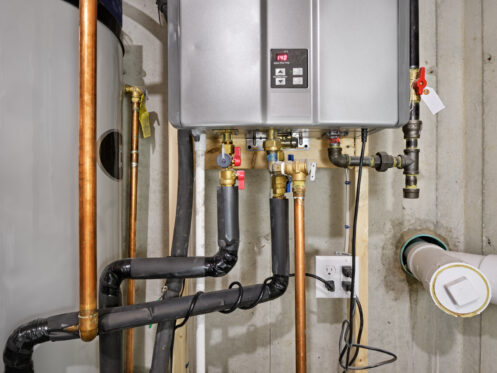It’s easy to put hot water heater maintenance aside until it starts leaking. No matter the reason for the leak, fixing this type of problem is crucial to both your comfort and your wallet. Knowing ahead of time what to do when your hot water heater leaks will help you repair the issue quickly, which can save time and money in the long run.
Common Causes of Hot Water Heater Leaks
Leaks in water heaters may occur for a number of reasons at any moment. Pinpointing the exact cause of a hot water heater leak is crucial to performing the correct repair. Some of the most common reasons that hot water heaters leak include:
- Old age
- Tank deterioration
- Deposition of sediment
- Internal tank corrosion
- Poorly secured plumbing, including leaky valves and fittings
- Super-heated water
- Frequent and extreme changes in temperature
- Problematic anode rod
- Incorrect assembly
- Inadequate upkeep
Shut Off the Power
Immediately upon recognizing a hot water heater leak, you should shut off the power to the appliance. This gets rid of the risk of you electrocuting yourself. The easiest way to turn off the power to the appliance is to flip its switch in the circuit breaker box.
If you have a gas hot water heater, you’ll also need to find its gas shutoff valve, which is typically located near the base of the tank in close proximity to the gas line that it’s connected to. Once you find it, turn the valve to the OFF position.
Turn Off the Cold Water Supply
Next, you’ll want to shut off the appliance’s cold water supply. Most times, the cold and warm water pipes are color-coded: blue for cold water and red for warm water. If the pipes aren’t color-coded, you can rub the back of your hand on the pipes to see which one feels warm and which one feels cold.
Locate the Leak
With both the power and cold water supply turned off, you can now inspect the hot water heater to see where it’s leaking. To do this, it’s helpful to first clean up the water that has already leaked out. Next, walk around the hot water heater to see where the water continues to leak.
Top Leaks
If you notice water leaking from the top of the water heater, there’s a good chance either the inlet or outlet (warm or cold) water pipe is the source of the leak. The pipes themselves connect to the hot water heater with fittings. If the fittings become loose, it can result in a water leak. The easiest way to fix this problem is to tighten the fittings using a pipe wrench.
Side Leaks
When water leaks down the side of a hot water heater, this signifies a possible problem with the temperature and pressure (T&P) relief valve. This valve serves as a safety measure, allowing the heater to release water in the event that too much water pressure builds up.
One reason that a T&P valve will leak is that the water temperature is set too high. Ideally, you should keep the water temperature set at 120 degrees Fahrenheit. It’s also possible for a T&P valve to leak simply because it’s faulty. You’ll have to hire a technician to replace a damaged or faulty T&P valve.
Bottom Leaks
It’s also possible for hot water heaters to leak from the bottom, particularly from the drain valve. Usually, the drain valve gets used during water heater maintenance sessions. It allows the technician to drain all the water from the appliance while performing repairs and maintenance tasks.
On some hot water heaters, the drain valve can become loose or stuck open, allowing water to leak. If this is the case, a technician can tighten the valve using a pipe wrench to see if it fixes the problem. The technician will know not to overtighten the valve, as this can lead to water leaks just as much as a loose valve. If tightening it doesn’t fix the problem, the technician will replace the drain valve.
Base Leaks
It’s also possible for hot water heaters to leak at the base when a crack is present. A cracked water heater, unfortunately, doesn’t come with an easy fix. Instead, you’ll have to replace the appliance, which requires removing the old water heater and having a new one installed.
When to Call a Plumber
If you inspect the hot water heater and notice loose fittings or valves, you can stay safe by letting a technician tighten or replace them. As the technician tightens the fittings and valves, he can inspect the appliance for other possible problems and make any necessary repairs.
How to Minimize Water Heater Leaks
The best way to prevent costly and annoying water heater issues is to have your unit inspected once a year. Professional water heater maintenance includes preventative measures to avoid cracks, leaks, and other issues.
During regular maintenance sessions, a technician will test the water heater’s thermostat to make sure it’s working as it should. The technician will also check the T&P valve to ensure it’s functioning correctly.
In homes with a gas water heater, a technician will help prevent water leaks by analyzing the appliance’s flue pipe. This allows the technician to confirm that the flue pipe properly vents all of the combustion gas that the water heater produces.
Furthermore, during water heater maintenance, a technician will inspect all pipes and fittings, examine the drain valve and possibly replace the anode rod. Having the anode rod inspected annually and replaced once every two to three years is vital to preventing cracks and water leaks.
Insulating the pipes may also aid in preventing hot water heater leaks. A technician will insulate the pipes by wrapping them in 3/8-inch-thick self-sticking foam pipe insulation. Foam of this kind slips smoothly over the pipes and protects against summertime condensation. The technician will use unfaced fiberglass pipe wrap, one inch thick, to protect the hot and cold water pipes if they are within six inches of the flue.
In addition to wrapping the pipes with insulation, you can insulate the entire appliance as well. To do this, a technician will use an insulating blanket with holes cut in it to accommodate the hot and cold pipes, temperature control buttons, T&P valve, and any gas lines. After wrapping the hot water heater, the technician will seal any cuts using foil tape.
Insulating the whole hot water heater adds additional protection against condensation. Water dripping down the flue tube onto the main burner extinguishes the pilot; hence, excessive condensation is a common cause of pilot outages. If you take care of this issue, you won’t have to worry about excessive condensation, a major cause of incorrect hot water heater leak diagnosis.
Fix Your Water Heater Leak Today!
A broken water heater makes it impossible to enjoy hot showers. It also makes it difficult to do dishes and laundry. You can get a hot water heater leak fixed today by calling Comfort Zone Heating & Air Conditioning. In addition to fixing water heater leaks, we specialize in drain cleaning, sump pump repair, sewer cleaning, tankless water heaters, furnace installation, AC repairs, indoor air quality improvement, and more. Contact Comfort Zone Heating & Air Conditioning now to book a repair session for your water heater leak in Cobourg, ON.




